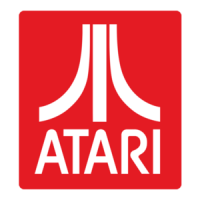The
functional
operation
of
the
Super Breakout
PCB
circuitry
begins naturally
enough
with
the
mi-
croprocessor
(or
MPU)
circuitry.
As
you
go
through
the
various
circuit
descriptions,
you
learn
how
the
MPU receives its
sequential
program
insructions
from
its
ROM
memory
and
how
it
carries
out
these
instructions
through
the
use
of
its display RAM
mem-
ory
(Section C);
how
it
reads in
the
game
control
switches (Section G),
and
how
it
writes
or
outputs
the
results
of
its
instructions
and
calculations
to
the
game's
other
PCB
circuitry,
such
as
the
playfield
generator
(Section
E),
the
motion
object
generator
(Section
F),
and
the
audio
amplifier
(Section
K).
A
circuit
description
of
the
standard Atari sync
generator
(Section D)
is
also
included.
This
is
the
only
PCB
circuitry
that
functions
independently
of
micro-
processor
control.
B.
POWER
SUPPLY
(See
Figure
3-3,
Sheet
1
of
5
and
Figure
3-5)
The
power
supply
produces
all
the
necessary
game
voltage
requirements
as
shown
in Figure 3-4.
The
PCB
receives
+10
volts DC,
unregulated,
at
pins B and 2
of
the
game
PCB
edge
connector;
16.5 VAC
to
pins C and 3 and D and 4; and
25
VAC
to
pins
Wand
19 and X and
20
from
the
secondary
of
the
transformer
located
on
the
Type B
power
supply
chassis.
The
+10
volts
is
rectified
and
filtered
off-board
and regulated
on-board
by
the
LM323
three-terminal
regulator
device
to
a stable
+5
volts DC. The
+5
volts
DC
is
distributed
throughout
the
PCB
to
power
all
logic
circuits. The 16.5 VAC
is
rectified
on-board
via
diodes
CR1
and CR2,
filtered
by
capacitor
C54
before
being
regulated
by
the
7905
to
produce
the
-5
volts
DC,
required
by
the
voltage
comparator,
LM319. The
25
VAC
input
is
rectified
through
diodes
CR3
and
CR4
filtered
by
capacitor
C55
and
supplied
as
unregulated
+20 volts
to
the
TDA
1004
audio
amplifier.
This
+20
volts
is
also regulated
by
a
three-terminal
device
7B12
(QB)
to
develop
+12
volts DC.
C.
MICROPROCESSOR
CIRCfilTRY
(See
Figure
3-3,
Sheet
2
of
5)
The
heart
of
the
Super Breakout game
PCB
is
the
microprocessor
circuitry.
A
brief
description
of
the
3-4
Super
Breakout
major
components
and
their
function
within
the
mi-
croprocessor
circuitry
is
provided
in
the
following
paragraphs.
Note
that
the
microprocessor
circuitry
components
include
the
following:
1. MPU (at location
C3)
2. Address buffers (A2, 82 and
C2)
3.
Data buffers
(E3,
E4)
4.
ROM
memory
(C1,
D1
and
E/F1)
for
-04
version
or
PROM
memory
as
listed in
the
PCB
assembly parts
list
for
the
-03
version (refer
to
Illustrated Parts
Catalog, Section 5).
5.
RAM
memory
(F4,
H4,
J4,
K4,
F3,
H3,
J3,
and
K3)
6.
Address
decoding
circuitry
(E2,
F2,
D2,
EB,
and HB,
and
miscellaneous gates)
7.
<l>O
clock
driver
(A7 and miscellaneous gates)
B.
Watchdog
reset
counter
(C6/7 and miscellaneous
gates)
MPU,
ROM,
and
RAM
(See
Figure
3-5)
The
microprocessor
is
the
"master
controller"
behind
all action
that
takes place in
the
game cir-
cuitry.
In
going
through
the
following
paragraphs
refer
to
Table 3-1, MPU
Input/Output
Signal De-
scriptions.
Upon
initialization,
the
MPU (via AO-A15)
addresses data
permanently
stored in
the
program
ROMs
or
PROMs. This addressed data
then
travels
to
the
MPU via its B-bit data bus
(DO
through
D7). The
MPU decodes this data
to
determine
what
action
it
is
to
perform
next (i.e.,
"read
coin switch
1,"
"ball
speed
up,"
etc.). The MPU uses RAM
memory
to
perform
many
of
these
instructions,
namely
to
tempo_rarily store
information
which
it
will
later re-
call. The MPU
is
capable
of
writing
(or
putting
data
into)
the
RAM and
then
later reading
(pulling
data
out
of)
the
RAM, via its address bus (AO-A15) and bi-
directional
data bus (DO-D7).
Address
Decoding
The MPU address
decoding
circuitry
performs
the
critical
function
of
turning
on
or
enabling
the
appropriate
game
circuitry
(i.e., RAM,
ROM,
latches,
etc.) at
the
appropriate
time,
so
that
information
can
be transferred back and
forth
between this game
circuitry
and
the
MPU. A
memory
map
defining
the
MPU
circuit
is
shown
in
Table
3-2
as
reference.

